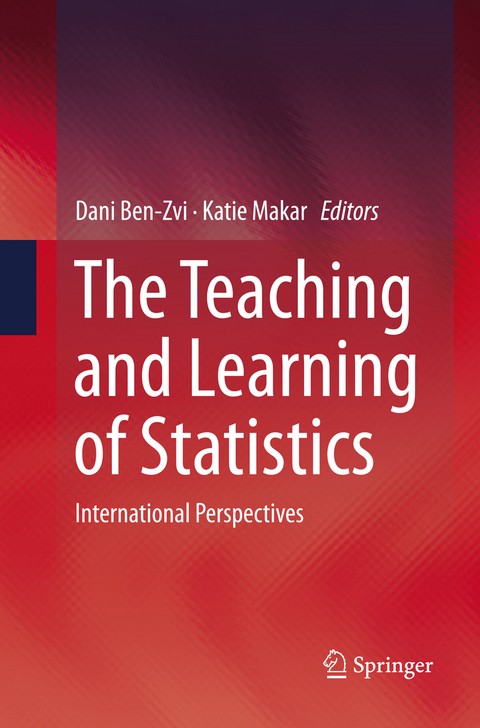
The Teaching and Learning of Statistics
Springer International Publishing (Verlag)
978-3-319-79488-4 (ISBN)
This book presents the breadth and diversity of empirical and practical work done on statistics education around the world. A wide range of methods are used to respond to the research questions that form it's base. Case studies of single students or teachers aimed at understanding reasoning processes, large-scale experimental studies attempting to generalize trends in the teaching and learning of statistics are both employed. Various epistemological stances are described and utilized.
The teaching and learning of statistics is presented in multiple contexts in the book. These include designed settings for young children, students in formal schooling, tertiary level students, vocational schools, and teacher professional development. A diversity is evident also in the choices of what to teach (curriculum), when to teach (learning trajectory), how to teach (pedagogy), how to demonstrate evidence of learning (assessment) and what challenges teachers and students face when theysolve statistical problems (reasoning and thinking).
Dani Ben-Zvi is an associate professor at the University of Haifa in the Faculty of Education, member of the Technology in Education Graduate Department, and member of the Mathematics Education Graduate Department. He is also the co-founder of the International Collaboration for Research on Statistical Reasoning, Thinking and Literacy, and co-chairs it with his co-editor, Katie Makar. His research interests include statistical reasoning and technology enhanced learning. He received his Ph.D. from the Weizmann Institute of Science in 2001 at the Department of Science Teaching. Dr Katie Makar is a senior lecturer in mathematics education at the University of Queensland. Her research looks at teaching of mathematics through inquiry. She is also known internationally for her work on statistical reasoning and informal statistical inference at the primary school level. She has done consulting work on teaching with inquiry, reasoning in chance and data, teacher professional standards and middle years curriculum. Her teaching includes courses in mathematics education, interdisciplinary curriculum, teacher professionalism, and statistics. Previously, she taught secondary mathematics for fifteen years in the US and Asia before finishing her PhD in 2004.
Introduction: International Perspectives on Teaching and Learning Statistics.- Young Students' Mental Modelling of Statistical Situations.- Learning to Integrate Statistical and Work-Related Reasoning.- Children Wonder how to Wander Between Data and Context.- Supporting Students to Develop Concepts Underlying Sampling and to Shuttle Between Contextual and Statistical Spheres.- The Language of Shape.- Development of an Understanding of a Sampling Distribution.- Korean High School Students' Understanding of the Concept of Correlation.- Connection Between Statistical Thinking and Critical Thinking?: A Case Study.- Tasks Associated to the Treatment of Tables at Elementary School and Its Level of Difficulty.- Characteristics of Abductive Explanation in Statistics Education of Lower Secondary School.- An Analysis of the Statistical Contents Covered in China, Singapore and Taiwan Mathematics Textbooks at the Primary Level.- Mathematical Modelling for Critical Statistics Education.- Survey andResearch on the Levels of High School Students' Critical Evaluation of Statistical Information and the Influence Factors.- Aspects of Statistical Literacy in Grades 5 and 6.- The Conceptual Understanding of Variability in the Data Distribution.- Students' Misconceptions and Mistakes Related to the Measurementin Statistical Investigation and Graphical Representation of Data.- Overall Understanding of the Middle School Mathematics Course in Teaching Statistics Main Line.- Growth on Fourth-Grade Students' Mathematical Understanding of Average.- The Disaster at the Nuclear Power Station and its District.- Exploring Dotplot in the Perspective of Embodied Cognition.- Students' Difficulties in Understanding the Confidence Intervals.- A Modeling and Simulation Approach to Informal Inference.- Students' Understanding Statistical Terms Having Lexical Ambiguity.- Student Understanding of Symbols in Introductory Statistics Courses.- Two Year College Mathematics Instructors' Concepts of Variation.- Students' Sense Making of Graphical Representation in Basic Statistics.- Teaching Some Basic Statistical Concepts by Experimentation.- Bootstrapping Confidence Intervals.- Undergraduate Students' Conceptions of Variability in a Dynamic Computer-Based Environment.- Transforming Statistics Education Through ICT Application.- Selecting Technology to Promote Learning in an Online Introductory Statistics Course.- The Role of Technology in Indian Statistic Education: A Review.- Building Up the Boxplot in Indian Statistics Education.- Building up the Boxplot as a Tool for Representing and Structuring Data Distributions.- Integrated Reasoning about Statistical Variation.-Preservice Teachers' Difficulties with Statistical Writing.- Teachers' Questions in the Statistics Class.- Statistical Training of Pre-Service Teachers with Application in School Practice.- Statistics in Primary Education in Greece.- Developing Statistical Literacy (DSL).- Teacher Capacity as a Key Element of National Curriculum Reform in Statistical Thinking.- A Framework for Assessing Statistical Knowledge for Teaching Based on the Identification of Conceptions of Variability Held by Teachers.- An Investigation into the Statistics Education of Pre-Service Mathematics Teachers at an Irish University.
"The investigations cover a broad range of issues regarding the education of students in statistics at the secondary and higher education levels, along with a few sections focused on the primary level. ... the book provides an effective compendium of studies regarding statistics education over a broad spectrum of teaching strategies. Summing Up: Highly recommended. Upper-division graduates through faculty." (N. W. Schillow, Choice, Vol. 53 (11), July, 2016)
| Erscheinungsdatum | 18.06.2018 |
|---|---|
| Zusatzinfo | VIII, 334 p. 85 illus., 53 illus. in color. |
| Verlagsort | Cham |
| Sprache | englisch |
| Maße | 155 x 235 mm |
| Gewicht | 528 g |
| Themenwelt | Schulbuch / Wörterbuch |
| Geisteswissenschaften ► Psychologie ► Pädagogische Psychologie | |
| Mathematik / Informatik ► Mathematik | |
| Sozialwissenschaften ► Pädagogik ► Schulpädagogik / Grundschule | |
| Schlagworte | International statistics education • Learning and Instruction • Statistics Education • Statistics teaching and learning • Technology in mathematics education • Technology in statistics education |
| ISBN-10 | 3-319-79488-4 / 3319794884 |
| ISBN-13 | 978-3-319-79488-4 / 9783319794884 |
| Zustand | Neuware |
| Haben Sie eine Frage zum Produkt? |
aus dem Bereich


